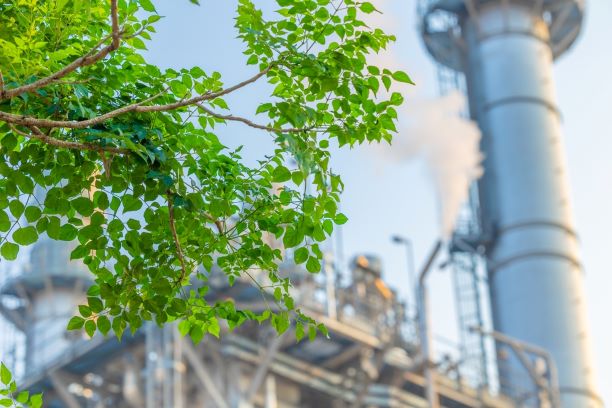Across industries, the move toward sustainability is no longer optional — it’s essential. .
Green Chemicals – The Path to Sustainable Desalination

As global water demand rises and natural freshwater sources become increasingly scarce, desalination is emerging as a crucial solution for many regions facing water shortages. However, traditional desalination methods can be both energy-intensive and environmentally harmful, largely due to their extensive use of chemicals and high energy consumption. To ensure desalination remains a sustainable option for providing clean water, innovative approaches are needed to minimize environmental impact while maximizing efficiency. This is where ‘green chemicals’ come into play, offering a transformative approach to desalination and industrial wastewater treatment.
What are ‘Green Chemicals’?
The concept of ‘green chemicals’ is revolutionizing desalination by creating a self-sustaining plant that eliminates the need for external inputs. Instead of relying on outside sources for the chemicals needed in the desalination process, the plant produces these chemicals on-site, cutting down transportation costs and significantly reducing its carbon footprint. This innovation highlights the core of green chemistry in desalination: maximizing resource efficiency while minimizing environmental harm.
But it doesn’t stop there. The approach is not only self-sufficient but also leverages rejected brine water, a byproduct of the desalination process as feedstock to produce valuable chemicals. This effectively reduces the environmental impact of discarded brine, turning a waste product into a resource.
Moreover, the minimization of environmental impact is achieved through several factors: eliminating the transportation of chemicals, utilizing renewable energy to produce these chemicals on-site, and employing energy-efficient production methods. This integrated approach reflects the future of sustainable desalination, where every element of the process works toward reducing environmental impact while maintaining operational efficiency.
Challenges with Traditional Chemical Use
Various chemicals play crucial roles across different stages of desalination , from pre-treatment to post-treatment, ensuring water quality and maintaining plant operations. However, they also present significant challenges, particularly in terms of supply chain logistics, cost management, and environmental impact. A large portion of the chemicals used in desalination plants, about 80%, consists of calcium carbonate and carbon dioxide, primarily utilized in the remineralization process to enhance the quality of desalinated water. Sodium hydroxide is the third most significant chemical, accounting for 11.6% of the total usage.
The reliance on these chemicals presents several challenges. Desalination plants are often located in remote or isolated areas, making the transportation and delivery of chemicals logistically difficult and costly. Transporting these chemicals not only adds to operational expenses but also increases the plant’s carbon footprint, which conflicts with sustainability goals. Stockpiling chemicals is not always feasible or cost-effective due to storage limitations and the risk of chemical degradation over time. For instance, supply chain disruptions affecting sodium hypochlorite can lead to plant shutdowns, impacting the reliability of the desalination process.
Chemical costs are another significant challenge. Prices can be volatile and unpredictable, driven by market conditions, supply and demand dynamics, and geopolitical factors. This volatility complicates financial planning and stability for desalination plant operations, as it affects operational budgets and makes cost forecasting difficult. Factors beyond production costs, such as transportation expenses, tariffs, and regulatory changes, can further influence chemical prices.
But what if we could overcome these challenges by producing chemicals on site? And what can be used to make chemicals on site?
The answer is easy. Seawater or rejected brine, which is typically twice as concentrated as seawater.
Seawater contains primarily sodium and chloride while sulfate, magnesium, calcium, and potassium are also present in significant amounts and with smaller amounts of bicarbonate, carbonate, and carbon dioxide. Seawater contains almost all the essential elements we need. The challenge lies in developing economical and environmentally friendly methods to extract the required chemicals from seawater or rejected brine for use in the desalination process.
Innovative Approaches to On-site Chemical Production
We began experimenting with a process to precipitate calcium carbonate from seawater around 10 years ago. The goal was to enhance the performance of thermal desalination plants by removing scale from seawater. Later, we expanded our work to the precipitation of various sparingly soluble salts in a fluidized bed reactor from different water sources. In recent years, we’ve also explored carbon capture techniques, particularly those involving capturing carbon from the sea.
We decided to integrate these processes to assess their combined impact on the desalination plant. When we brought these elements together, we discovered that this approach not only captures carbon from the air but also produces essential chemicals for the desalination plant. And there’s a bonus here… this process also enhances the plant’s overall performance, enabling improved boron removal, biofouling free operation of RO membranes, anti-scalant free operation, and a significant reduction in the plant’s size since there is no longer a need to construct a large second pass reverse osmosis stage designed for boron removal.
Introducing: Our green chemicals production sustainable desalination process (SDP)
The on-site production of chemicals for desalination plants involves a series of innovative steps designed to extract and utilize essential components directly from seawater or rejected brine. The process begins with the intake of raw seawater or concentrated brine, which is directed into a fluidized bed reactor. In this reactor, calcium hydroxide is added to precipitate calcium carbonate on the available particles or pellets. The fluidized bed reactor is a well-established technology where water flows upward through a bed of fluidized particles, promoting the efficient precipitation of calcium carbonate. The reactor operates at a high upflow velocity of about 80 to 120 meters per hour, which allows for a compact footprint and produces highly dry calcium carbonate crystals, eliminating the need for additional dewatering stages. The effluent from the reactor contains relatively low concentrations of suspended solids, meaning existing filtration technologies at the desalination plant can be used without additional treatment.
Next, the part of calcium carbonate pellets produced in the fluidized bed reactor is transported to the remineralization process while another part is transported to a calciner, where they undergo thermal decomposition at temperatures exceeding 900°C. This high-temperature process breaks down the calcium carbonate into calcium oxide (quicklime) and carbon dioxide gas. Various types of calciners, such as regenerative or rotary kilns, can be employed depending on factors like pellet size, energy consumption, and the desired purity of the carbon dioxide produced. We prefer to use an electrically operated calciner because it produces a cleaner carbon dioxide stream with carbon dioxide concentrations higher than 90%, which reduces the need for extensive cleaning or liquefaction, making the process both cost-effective and energy-efficient.
The chemicals produced on-site, including calcium carbonate, calcium oxide and carbon dioxide, are then utilized in the desalination plant’s post-treatment stage to enhance water quality. Calcium oxide is used in the fluidized bed reactor itself and for pH adjustment in desalination processes, replacing the more commonly used sodium hydroxide and thereby reducing chemical costs.
Using seawater for chemical production offers several advantages for the desalination process. Higher pH enables more efficient boron removal in the first stage, resulting in a smaller second stage for boron elimination. Additionally, elevated pH prevents or reduces biofouling, extending the intervals between membrane cleanings required to remove biofouling. Furthermore, reducing calcium levels produces softened seawater, allowing for antiscalant-free operation. These benefits collectively enhance the efficiency and sustainability of the desalination process.
The chemical production process described above can be integrated into existing seawater desalination plants by installing it on the rejected brine stream.
‘Green Chemicals’ Production – Paving the Way to Sustainable Desalination
Producing chemicals on-site offers numerous benefits, such as a steady supply of essential materials, cost savings from reduced transportation and procurement expenses, and a significant reduction in the carbon footprint associated with chemical production and transport. This innovative approach minimizes environmental impact and enhances operational efficiency, aligning with global sustainability goals and paving the way for more sustainable desalination practices. By developing on-site chemical production capabilities, desalination plants can not only meet their immediate chemical needs but also operate more sustainably and cost-effectively, ensuring a reliable supply of clean water while reducing their overall environmental footprint.
How can we generate chemicals from seawater for use in desalination plants? Watch our webinar.
Contact us to explore how IDE Water Technology can help you achieve your sustainability goals.
















